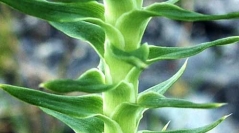The Chapada dos Veadeiros National Park is a conservation unit established to preserve the highest savannahs of Central Brazil and their unique biodiversity. Eriocaulaceae are a relevant and conspicuous family in such high savannahs, but its diversity is poorly known, documented solely in general lists or in isolated efforts aimed at small groups. After a structured series of field expeditions and analysis of specimens from the relevant herbaria, we provide nomenclatural novelties, a first identification key, and an illustrated checklist for the species of Paepalanthoideae (Eriocaulaceae) in the area. We recorded 42 species of Paepalanthoideae from the Chapada dos Veadeiros National Park: Actinocephalus (Körn.) Sano (2 spp.), Comanthera L.B.Sm. (1 sp.), Paepalanthus Mart. (24 spp.), and Syngonanthus Ruhland (15 spp.). Actinocephalus brevifolius Trovó & Echtern. sp. nov. and P. irwinii Trovó & Echtern. sp. nov. are newly described species and P. politus Trovó stat. et nom. nov. is a variety of P. elongatus (Bong.) Körn. raised to the species status with a new name. The generic and specific composition shows predominance of Paepalanthus and Syngonanthus, and with a low representation of Actinocephalus and Comanthera, as expected, outside of the Espinhaço Range. More than 50% of the species (22 spp.) are endemic to the area and 25 species are endemic to Central Brazil, the area being the main center of diversity for dimerous-flowered groups. The non-endemic diversity is a combination of widespread species and marginal distribution of species typical from the Amazon and southeastern savannahs. The species are unevenly distributed in the area, with their occurrence correlated to altitude, water availability, and lithology. We reinforce that the savannahs from Central Brazil are a secondary center of diversity for Eriocaulaceae, playing a central role in the conservation of an unique and irreplaceable piece of its diversity and the Cerrado biome as well.


 European Journal of Taxonomy
834 (58) - Pages 58-93
European Journal of Taxonomy
834 (58) - Pages 58-93